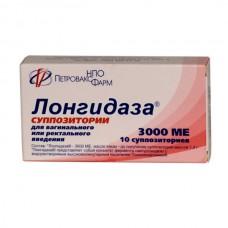Expiration date: 12/2026
The composition and form of issue:
Suppositories for vaginal or rectal use. 1 suppositorie contains:
Longidaza with hyaluronidase activity 3000 ME
excipients: cocoa butter — to obtain the suppository mass of 1, 3 g
in a contour acheikova package 5 PCs. in cardboard pack 1 or 2 packs.
Description pharmaceutical form:
Suppositories are torpedo-shaped, light yellow color with a weak specific smell of cocoa butter, marbling staining.
Feature:
Longidaza is a conjugate of hyaluronidase with an activated derivative N-oxide, poly-1, 4-etilenpiperazina.
Pharmacokinetics:
Experimental study of pharmacokinetics of the suppositories with a carrier of the enzyme, labeled with tritium, revealed that rectal administration of the drug is characterized by a high rate of distribution in the body, well absorbed into the systemic circulation and reaches the Cmax in the blood after 1 h Period of poluraspredelenia — about 0, 5 h, the period of preliminaly from 42 to 84 h. report mostly kidneys.
The drug penetrates into all organs and tissues, including passes through GEB and gematoentsefalichesky barrier. The lack of tissue accumulation.
The bioavailability of rectal suppositories of Longidaza — at least 70%.
Description pharmacological action:
Longidaza has hyaluronidase (a proteolytic enzyme) activity prolonged action, gelatinous, antioxidant, immunomodulatory and moderate anti-inflammatory properties.
The prolongation of the action of the enzyme is achieved by covalently binding it with physiologically active macromolecular carrier (activated derivative N-oxide, poly-1, 4-etilenpiperazina with its own pharmacological activity. Longidaza shows protivovirusnye properties weakened during the acute phase of inflammation, regulates (increases or decreases depending on the initial level) the synthesis of inflammatory mediators (IL-1 and tumor necrosis factor-alpha) enhances humoral immune response and resistance of organism to infection.
Expressed protivovirusnye properties of Longidaza is provided by the conjugation of hyaluronidase with the carrier, which greatly increases the stability of the enzyme to the denaturing effects and the action of inhibitors: enzymatic activity of Longidaza is saved when heated to 37 °C for 20 days, while the native hyaluronidase in the same conditions loses its activity during the day. In preparation Longidase simultaneous local presence of proteolytic enzyme hyaluronidase and media capable of binding the liberated during hydrolysis of the components of the matrix — enzyme inhibitors and stimulators of collagen synthesis (ions of iron, copper, heparin, etc.). Thanks to the above properties Longidaza not only has the ability to depolymerize the matrix of the connective tissue in fibro-granulomatous formations, but also to suppress the reverse regulatory reaction aimed at the synthesis of components of connective tissue.
A specific substrate of hyaluronidase are glycosaminoglycans (hyaluronic acid, chondroitin, chondroitin-4-sulfate, chondroitin-6-sulfate), form the basis of the matrix of connective tissue. As a result of depolymerization (break the connection between C1 and C4 acetylglucosamine glucuronic or indianboy acid) glycosaminoglycans alter their main properties: reduced viscosity, reduced ability to bind water, metal ions, temporarily increases the permeability of tissue barriers, facilitates the movement of fluid in the intercellular space, increases the elasticity of connective tissue, which is manifested in the reduction of swelling tissue, flattening scars, increase range of motion of joints, reduce contractures and the prevention of their formation, reduction of adhesions.
Biochemical, immunological, histological and electron-microscopic studies proved that Longidaza does not damage normal tissue, it causes destruction and changed the composition and structure of connective tissue in the area of fibrosis.
Longidaza is not mutagenic, embryotoxic, teratogenic and carcinogenic.
The drug is well tolerated by patients that are not marked local and General allergic reactions.
Use of Longidaza in therapeutic doses during or after surgery does not cause deterioration in the postoperative period or progression of the infectious process does not slow bone recovery.
Indications:
Adults and children over 12 years as monotherapy and in the complex therapy of diseases accompanied by hyperplasia of connective tissue, including on the background of inflammatory process:
urology: chronic prostatitis, interstitial cystitis, urethral stricture and urinary tract, Peyronie's disease, early onset benign prostatic hyperplasia, prevention of scarring and strictures after surgical interventions on the urethra, bladder, ureters
in gynecology: adhesions (prevention and treatment) in the pelvis in chronic inflammatory diseases of internal genital organs after gynecological manipulations, including induced abortions, migrated surgical interventions on the pelvic organs: sinehii intrauterine, tubal-peritoneal infertility, chronic endomyometritis
in dermatology: limited scleroderma, prevention of fibrotic complications of sexually transmitted infections
in surgery: prevention and treatment adhesions after surgical interventions on the abdominal organs, nonhealing wounds
in pulmonology and Phthisiology: pulmonary fibrosis, sideros, tuberculosis (cavernous-fibrotic, infiltrative, it's a tuberculoma), interstitial pneumonia, fibrosing alveolitis, pleuritis
to increase the bioavailability of antibiotic therapy in urology, gynecology, dermatology, surgery, pulmonology.
Contraindications:
- increased individual sensitivity to drugs with hyaluronidase activity, Longidase
- malignant neoplasms
- pregnancy (clinical experiences none)
- children up to age 12 years (efficacy and safety have not been studied).
With care (suppositories not apply more than 1 time a week):
- acute renal failure
- pulmonary hemorrhage (in anamnesis).
Side effects:
Rarely, allergic reactions with increased individual sensitivity.
Drug interactions:
When using Longidaza in patients receiving large doses of salicylates, cortisone, ACTH, estrogens or antihistamines may be reduced the efficiency of the enzyme hyaluronidase.
When administered in combination with other drugs should consider the possibility of increasing their absorption (bioavailability) and gain systemic effects.
Method of application and dose:
Rectal, after purgation, or vaginally, in the prone position — 1 supp. 1 time a day at night, a course of 10 to 20 injections.
The scheme of injection is adjusted depending on the severity, stage and duration of disease: Longidaza is assigned a day or at intervals of 2-3 days.
The recommended circuit and dosages:
- urology: 1 supp. through day 10 injections, then after 2-3 days, 10 — introductions, General course of 20 supp.
- in gynecology: vaginally or rectally 1 supp. 2 days — 10 injections, then be administered if necessary supportive therapy
- dermatology: 1 supp. 1-2 days — 10-15 injections
- surgery: 1 supp. 2-3 days — 10 introductions
- in pulmonology and Phthisiology: 1 supp. 2-4 days — 10-20 injections.
If necessary, it is recommended to repeat the course of Longidaza not earlier than 3 months or long-term maintenance therapy — 1 supp. 1 every 5-7 days for 3-4 months.
Special instructions:
To suspend the use of Longidaza in the development of allergic reactions.
When applying on the background of aggravation of foci of infection to prevent the spread of infection to appoint under the guise of antimicrobial agents.



